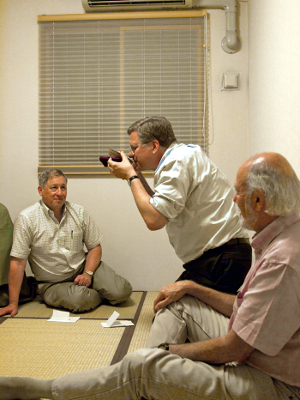
Attendees for the first day of the kick-off meeting for ILC detector studies. Image: Nobuko Kobayashi
From 12 to 14 September, about 60 scientists gathered at Tohoku University, Sendai, Japan, to attend the kick-off meeting for a global R&D programme of a state-of-the-art detector system for the ILC.
A large part of ILC detector R&D had been implemented with grants awarded by the Japan Society for the Promotion of Science (JSPS), an independent administrative institution that works within the framework of Japanese government policies to promote scientific advancement. JSPS also carries out its own programmes aiming for the advancement of science in all fields.
This year, Japanese scientists were awarded a new five-year JSPS grant: a grant-in-aid for a special-promoted research project entitled ‘A global R&D programme of a state-of-the-art detector system for ILC’, which will cover detector activities even after the publication of the Detailed Baseline Design Report (DBD).
This meeting not only kicked off a Japanese research grant on ILC physics and detector studies, it was also “planned to be international and as open as possible to the world,” said Hitoshi Yamamoto, chair of the meeting and Asian regional contact for the ILC research directorate. “The goal of this programme is to realise a detector system based on the particle flow algorithm, which requires detector elements with super-high granularity. We are going to accomplish this goal within international frameworks in close collaboration with our colleagues overseas.”

Jim Brau (left), Jon Bagger (middle) and Barry Barish (right) enjoying the harvest moon with a traditional tea ceremony held at Hitoshi Yamamoto's residence near Tohoku University. Image: Nobuko Kobayashi
Indeed, many scientists from overseas delivered talks during the meeting, including Jonathan Bagger, chair of the International Linear Collider Steering Committee (ILCSC), and Barry Barish, Director of the Global Design Effort (GDE). “By inviting speakers from North America and Europe to this meeting, it strengthens the position of the Japanese scientific community in general,” Yamamoto said. When Bagger agreed to come to the meeting, he wrote to Yamamoto, “When travelling to Japan, I will be able to help send a signal of the importance of the Japanese ILC effort to the international community.”
During two-and-a-half days of intense sessions, attendees discussed many aspects regarding ILC detector studies and heard talks from leaders of overseas ILC detector groups. “We were able to clearly see how our own efforts were positioned in the international effort. This was a good start to make our five-year plan effective towards the DBD and beyond,” said Yamamoto.
On the last half-day of the meeting, some of the attendees took a trip to one of the two Japanese candidate sites for the ILC, taking the opportunity of already being close to the site.
The scientists took a Shinkansen bullet train from Sendai to Ichinoseki and briefly visited Hiraizumi, the new world heritage site. After a roughly one-hour bus ride from Hiraizumi, seeing the carpet of ready-to-reap rice fields and the little apple trees, the delegation reached the green hill.
Towards the end of the excursion, Yamamoto explained to Jim Brau, regional contact for the ILC research director, where the entrance of the access tunnel to the experimental hall was expected to be. “Jim went close to the site and took a couple of pictures, and on the way back to the bus, he said to me ‘OK, when do you start digging?’. I know it was just a joke, but I felt that taking a trip to one of the candidate sites enlarged our vision and made the ILC more real to us,” said Yamamoto.

Recent Comments